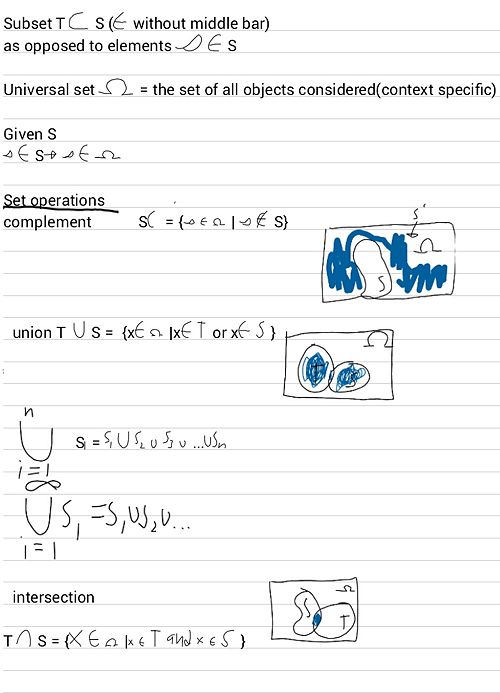| Line 12: | Line 12: | ||
S = {sin(2<span class="texhtml">π</span>*440t),sin(2<span class="texhtml">π</span>*880t),sin(2<span class="texhtml">π</span>*1320t),...} | S = {sin(2<span class="texhtml">π</span>*440t),sin(2<span class="texhtml">π</span>*880t),sin(2<span class="texhtml">π</span>*1320t),...} | ||
| − | + | Observe <math>_{S = \mathbb{R}}</math> is not routable; S = [0,1] is not routable | |
| − | + | S = {sin(2<span class="texhtml">π</span>*f*t)} f <math>\in \mathbb{R} \geq</math> 0 | |
| − | + | = {sin(2<span class="texhtml">π</span>*f*t)|0<math>\leq f < \infty</math>} | |
<math>\mathbb{Z}</math> is all integers <math>-\infty</math> to <math>\infty</math>  | <math>\mathbb{Z}</math> is all integers <math>-\infty</math> to <math>\infty</math>  | ||
| Line 26: | Line 26: | ||
Many different ways to write a set [0,1] = {x <math>\in \mathbb{R} </math>such that(s. t.) 0<math>\leq x \leq</math> 1} ={real positive numbers no greater than 1 as well as 0} | Many different ways to write a set [0,1] = {x <math>\in \mathbb{R} </math>such that(s. t.) 0<math>\leq x \leq</math> 1} ={real positive numbers no greater than 1 as well as 0} | ||
| − | [[Image: | + | [[Image:100 3.jpg|left|500x700px]] |
| − | + | ||
| − | + | ||
| − | + | ||
| − | + | ||
| − | + | ||
| − | + | ||
| − | + | ||
| − | + | ||
| − | + | ||
| − | + | ||
| − | + | ||
| − | + | ||
| − | + | ||
| − | + | ||
| − | + | ||
| − | + | ||
| − | + | ||
| − | + | ||
| − | + | ||
| − | + | ||
| − | + | ||
| − | + | ||
| − | + | ||
| − | + | ||
| − | + | ||
| − | + | ||
| − | + | ||
| − | + | ||
| − | + | ||
| − | + | ||
| − | + | ||
| − | + | ||
| − | + | ||
| − | + | ||
| − | + | ||
| − | + | ||
| − | + | ||
| − | + | ||
| − | + | ||
| − | + | ||
| − | + | ||
| − | + | ||
| − | + | ||
| − | + | ||
| − | + | ||
| − | + | ||
| − | + | ||
| − | + | ||
| − | + | ||
| − | + | ||
| − | + | ||
| − | + | ||
| − | + | ||
| + | <br> | ||
---- | ---- | ||
Go to lecture notes: [[ECE302S13Notes|2]] [[302L3|3]] [[302L4|4]] [[302L6|6]] [[302L7|7]] [[302L8|8]] [[302L9|9]] [[302L10|10]] [[302L12|12]] [[302L18|18]] [[302L20|20]] [[302L32|32]] [[302L35|35]] [[302L37|37]] [[302L38|38]] [[302L39|39]] | Go to lecture notes: [[ECE302S13Notes|2]] [[302L3|3]] [[302L4|4]] [[302L6|6]] [[302L7|7]] [[302L8|8]] [[302L9|9]] [[302L10|10]] [[302L12|12]] [[302L18|18]] [[302L20|20]] [[302L32|32]] [[302L35|35]] [[302L37|37]] [[302L38|38]] [[302L39|39]] | ||
Revision as of 05:04, 15 April 2013
Note: this is the first of many pages to be uploaded.
1/9/13
If S is discrete and finite S = {s1,s2,s3} S = {head,tail}, S = {win, lose}, S = {1,2,3,4,5,6}
If S is discrete but infinite,
S = {s1,s2,s3,...} ex. S = {1,2,3,4,...}
S = {sin(2π*440t),sin(2π*880t),sin(2π*1320t),...}
Observe $ _{S = \mathbb{R}} $ is not routable; S = [0,1] is not routable
S = {sin(2π*f*t)} f $ \in \mathbb{R} \geq $ 0
= {sin(2π*f*t)|0$ \leq f < \infty $}
$ \mathbb{Z} $ is all integers $ -\infty $ to $ \infty $ 
Is $ \mathbb{Z} $ routable? yes.
$ \mathbb{Z} $={0,1,-1,2,-2,3,-3, }as opposed to $ \mathbb{R} $
$ \mathbb{R} $= {0,3,e,π,-1,1.14,$ \sqrt{2} $}
Many different ways to write a set [0,1] = {x $ \in \mathbb{R} $such that(s. t.) 0$ \leq x \leq $ 1} ={real positive numbers no greater than 1 as well as 0}
Go to lecture notes: 2 3 4 6 7 8 9 10 12 18 20 32 35 37 38 39


